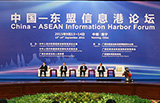Mining to become key to Tibet's economy
By Du Juan in Tibet (China Daily) Updated: 2012-07-09 09:03Prosperous planning
Located in the largest and highest plateau in the world, Tibet has rich mining resources with its unique natural geographic features. Analysts estimate that the mining industry will account for one third of the region's gross domestic product and become the most important industry in the area.
According to the Land and Resources Office of the autonomous region, Tibet has 101 kinds of proven reserves, among which many resources such as copper, gold, chromium and boron are in short supply in China. The chromic iron ore reserve is the biggest in China and the copper reserve the second biggest.
The office said the potential value of the mining resources in Tibet is more than 600 billion yuan.
Huatailong is the only subsidiary company of China Gold in Tibet. Most products are sold to Jinchuan Group Co, the third largest copper producer in China, said Teng Yongqing of Huatailong.
Tibet Mineral Development Co, which was formed in 1994 and listed on Shenzhen Stock Exchange in 1997, has a longer history than Huatailong in Tibet's mining industry. It is engaged in the exploration and collection of ferrous metal mines and involved in the exploration and sale of chromite, the processing and sale of ferrochrome and the exploration of copper, iron, lithium and boron.
Teng, who used to work for another gold mining company under China Gold in Sichuan province and has been working in Tibet for two years, told China Daily that the company plans to build its own smelting plant.
Asked about competition in the region, he said it is not "tough" now even though many mining companies are seeing the importance and opportunities in Tibet but the high technology requirements to operate at the high altitude deterred some.
"The mining industry is still in its infancy in Tibet and the priority is to help the region to develop it together for all the mining companies," he said.
He estimated that the company will produce 12,000 tons of copper in 2012.
The world's consumption of copper during the first four months was nearly 7 million tons, and China makes up 44 percent of the world's use of it at 3 million tons, according to the World Bureau of Metal Statistics.
The bureau said there was a shortage of 277,000 tons of copper in the world market during the first four months.
The second phrase of the Jiama project with an investment of more than 5 billion yuan is now being prepared. According to the company, it will be completed by the end of 2013.
After the completion of the second phrase, the Jiama project will have a daily mining production capacity of 4,000 tons. When the company finishes the construction of the underground mining system by the end of 2014, the daily capacity will reach 20,000 tons.
The company said after completion, annual output will reach 50,000 tons of copper, 1.2 tons of gold and 50 tons of silver. At current prices, the yearly sales revenue of the company will reach 4.50 billion yuan with profits of 1.18 billion yuan.
According to the region's 12th Five-Year Plan (2011-15), the Tibet mining industry will need governmental financial support of 16 billion yuan and social investment of 32 billion yuan. The newly added mineral reserves will reach 2,000 billion yuan by 2015.
The total output value of the industry in Tibet will reach 40 billion yuan by the end of 2015 and 80 billion by 2020.
Sun Zhaoxue, chairman of China Gold, the only central State-owned enterprise in the gold industry in the country, said it will accelerate development of the second phase of the Jiama project and, by 2014, the company will have an annual production capacity of 63,000 tons of copper, which is valued at 4 billion yuan according to the current price.
Plans also call for Jiama to be one of the top nonferrous metal production sites in the world in five years.
The company has invested 280 million yuan in exploration and estimates the area holds 8 million tons of proven copper ore reserves, 20 times more than in 2007 when the company began mining in the region.
According to public data, China Gold increased its total gold reserves from 275 tons in 2006 to 1,380 tons in 2011. Its overall copper reserves increased from 1.25 million tons to 9.9 million tons in the period.
Sun said the company envisages tripling both its total assets and revenues from 2011 to 2015 with the aim of joining top-tier global mining companies.
dujuan@chinadaily.com.cn
- China drives global VC funding to record high
- China's financial sector grows stronger
- A double life by day and night
- Monetary easing encourages fixed-income asset investment: Report
- China comes to Africa as partner: former Kenya PM
- China lowers 2015 electricity use estimate
- China's growth still impressive, services activity picks up
- Emerging markets can benefit from China's experience

















